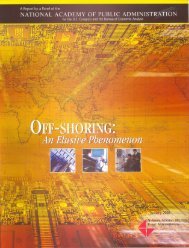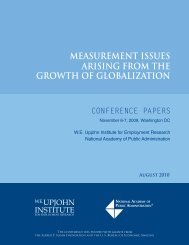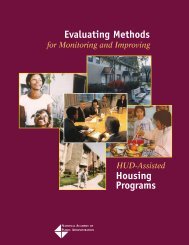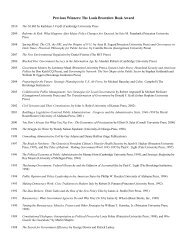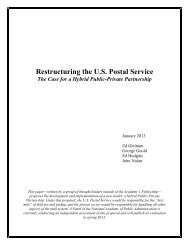High-Performance Partnerships - National Academy of Public ...
High-Performance Partnerships - National Academy of Public ...
High-Performance Partnerships - National Academy of Public ...
You also want an ePaper? Increase the reach of your titles
YUMPU automatically turns print PDFs into web optimized ePapers that Google loves.
ORGANIZATIONAL INFRASTRUCTURE<br />
chapter nine<br />
G<br />
ood intentions and a supportive environment cannot overcome a faulty internal foundation.<br />
With a supportive environment, right partners at the table, and the capacity to<br />
deliver, a partnership must then have a clearly defined governance structure, support<br />
systems and qualified staff to operate effectively.<br />
A team approach to problem solving is incompatible<br />
with a control mentality. A partnership is<br />
unfeasible if partners are unwilling to sacrifice<br />
some control to share decision-making,<br />
resources, and accountability for results.<br />
Similarly, some organizations are not prepared<br />
for a high-performance environment. Outcome<br />
measurement and accountability are relatively<br />
new to the public and nonpr<strong>of</strong>it sectors. Some<br />
monitor their service outputs, but do not report<br />
meaningful outcomes—that is, fundamentally<br />
improved community conditions or client<br />
behavior. Often, a public or nonpr<strong>of</strong>it agency<br />
measures its performance by the volume <strong>of</strong> work,<br />
not the results.<br />
Participating in a high-performance partnership<br />
means agreeing to be held accountable for complex<br />
community outcomes. For example, a partnership<br />
has not reached the high-performance<br />
plateau if it is willing to count the number <strong>of</strong><br />
expectant mothers served, but unwilling to establish<br />
goals for increasing the percentage <strong>of</strong> healthy<br />
babies born to them.<br />
Second, the partnership’s environment must be<br />
conducive to cross-sector collaboration. In some<br />
cases, neither the community nor potential partners<br />
have developed significant trust that would<br />
permit an effective relationship. Such dynamics<br />
can significantly hinder collaboration. Other limitations<br />
include an overly controlling public sector,<br />
a civic sector distrustful <strong>of</strong> government, and a<br />
nonpr<strong>of</strong>it sector with limited capacity. Unless<br />
perceived limitations can be overcome, a supportive<br />
stakeholder environment and performancebased<br />
partnership are unlikely to occur.<br />
To evaluate its partnership projects, CMS’ Partnership<br />
Development Group has developed a pre-assessment<br />
form to determine the likelihood <strong>of</strong> success when partnering<br />
with an organization and a post self-assessment<br />
form to evaluate a completed partnership or outreach<br />
activity. This formal assessment can be very useful in<br />
building a collaborative effort with all the necessary<br />
ingredients.<br />
HOW TO MEET CHALLENGES<br />
TO ORGANIZATIONAL<br />
INFRASTRUCTURE<br />
ACHIEVING THE RIGHT MIX OF<br />
CAPABLE PARTNERS<br />
The Challenge<br />
Outreach Self-Assessment Forms,<br />
Centers for Medicare and Medicaid Services<br />
A long-term performance-based partnership<br />
depends on the right complement <strong>of</strong> members.<br />
Sometimes, a community will seek a partnership<br />
<strong>of</strong> available and willing participants. This<br />
may produce immediate buy-in, but fail to<br />
attract critical expertise and resources.<br />
<strong>Partnerships</strong> also must identify entities that<br />
should not be included. The assumption may<br />
be “the more the merrier,” but this is not<br />
always the best approach. Participants that do<br />
not contribute effectively only hurt the partnership’s<br />
performance and sustainability.<br />
There must be balance between broad-based<br />
buy-in and inclusion for inclusion’s sake.<br />
110 Powering the Future: <strong>High</strong>-<strong>Performance</strong> <strong>Partnerships</strong>




